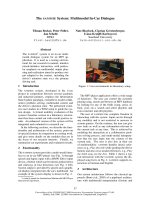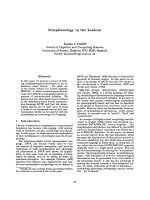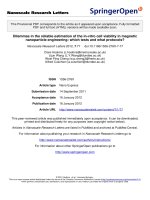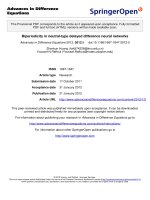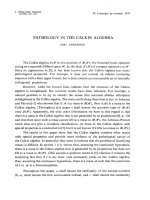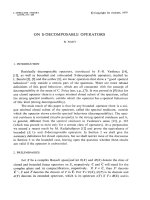Báo cáo toán học: "Descents in Noncrossing Trees." doc
Bạn đang xem bản rút gọn của tài liệu. Xem và tải ngay bản đầy đủ của tài liệu tại đây (75.35 KB, 5 trang )
Descents in Noncrossing Trees.
David S. Hough
∗
Department of Mathematics
Howard University, Washington, DC, USA
Submitted: Jun 18, 2002, Accepted: Oct 6, 2003; Published: Oct 13, 2003
MR Subject Classifications: 05C30, 05A15
Abstract
The generating function for descents in noncrossing trees is found. A bijection
shows combinatorially why the descent generating function with descents set equal
to 2 is the generating function for connected noncrossing graphs.
1 Introduction
A noncrossing tree is a tree drawn on n points numbered in counterclockwise order on
a circle such that the edges lie entirely within the circle and do not cross. A descent
is an edge from a higher to a lower label along a path from the root 1. We frequently
use “g.f.” to stand for “generating function”. In Section 2, we find the descent g.f.
for noncrossing trees. In Section 3, we show a bijection between noncrossing trees and
connected noncrossing graphs that explains combinatorially why the g.f. for connected
noncrossing graphs equals the descent g.f. evaluated at 2.
2 Descents in Noncrossing Trees
Consider, as in [2], a noncrossing tree as a sequence of butterflies. Let
T (z, u, v)=
τ
z
|τ |
u
d(τ )
v
a(τ )
, (1)
where the sum is over all trees τ,thesize|τ| is the number of edges, d(τ)isthenumber
of descents, and a(τ ) is the number of ascents. A butterfly is an ordered pair of subtrees
T and T
∗
that lie on either side of an edge (1,i) from the root to point i, T on points
∗
Thanks to Louis W. Shapiro and Frank W. Schmidt for useful discussions, and to the anonymous
referee for an alternative proof that also proved a conjecture in the original paper.
the electronic journal of combinatorics 10 (2003), #N13 1
greaterthanorequaltoi and T
∗
on points less than or equal to i, not including 1. Then
we have
T (z, u, v)=
1
1 − vzT(z, u, v)T (z, v, u)
(2)
T
*
T
T
*
T
T
*
T
1
vz
vz
vz
Figure 1: A butterfly diagram of noncrossing trees, where T stands for T (z, u, v)andT
∗
for T (z,v,u).
This is because when the tree is rooted at 1, every edge from 1 contributes one to
the size and one ascent; and because in one of the two wings of a butterfly the role of
ascents and descents is exchanged (see Figure 1). That is, T = T (z, u, v)andT
∗
=
T (z, v, u). Similarly, T (z, v, u)=1/[1 − uzT(z,u,v)T(z,v,u)], and eliminating we have
that D(z,u):=T (z, u, 1), the bivariate g.f. in which z marks edges and u descents,
satisfies the cubic equation
zD
3
+(u − 1)D
2
+(1− 2u)D + u =0 (3)
Theorem 2.1. The descent g.f. D(z, u) evaluated at u equal to −1, 0, 1, and 2 gives
the g.f.’s for symmetric ternary trees, Catalan numbers, ternary numbers, and connected
noncrossing graphs, respectively.
Proof. If u =0oru =1,thenequation(3)reducestoD =1+zD
2
or D =1+zD
3
,the
g.f.’s for the Catalan and ternary numbers, respectively.
If u =2,thenequation(3)becomeszD
3
+ D
2
− 3D + 2, the g.f. for connected
noncrossing graphs as in equation (17) of [2] (let C = zD).
If u = −1, then equation (3) becomes zD
3
− 2D
2
+3D − 1 = 0. To see that this
is the g.f. for symmetric ternary trees R(z), note that a symmetric ternary tree can
be decomposed into a ternary left subtree, a central symmetric ternary subtree, and a
right subtree that is a reflection of the left subtree, as shown in Figure 2. Thus R(z)=
1+zT(z
2
)R(z), and from this and the g.f. T (z)=1+zT(z)
3
for ternary trees, one
obtains zD
3
− 2D
2
+3D − 1=0.
the electronic journal of combinatorics 10 (2003), #N13 2
z
TRT’
Figure 2: The g.f. for symmetric ternary trees R is related to the g.f. for ternary trees
T (z)=1+zT(z)
3
by R(z)=1+zR(z)T (z
2
).
Now set D = B + 1 and apply Lagrange inversion to obtain the coefficients for the
bivariate g.f. for noncrossing trees by edges and descents. That is, we get B = z(1 +
B)
3
/[1+(1−u)B], an equation of the form B = zφ(B), so the Lagrange Inversion formula
gives the generating function B =
∞
n=1
b
n
z
n
where b
n
=
1
n!
d
n−1
dB
n−1
[φ(B)
n
]
B=0
.
Theorem 2.2. The coefficients of the g.f. D(z, u)=
n≥0
d
n
z
n
are given by d
n
=
n−1
k=0
1
n
n−1+k
n−1
2n−k
n+1
u
k
.
Proof. The Lagrange Inversion formula gives the coefficient of u
k
as a sum of the product
of three binomial terms; the terms of the sum are terms of a hypergeometric series that
can be evaluated by Gauss’s
2
F
1
identity.
Edges n Descent g.f.
1 1
2 2+u
3 5+5u +2u
2
4 14 + 21u +15u
2
+5u
3
5 42 + 84u +84u
2
+49u
3
+14u
4
6 132 + 330u + 420u
2
+ 336u
3
+ 168u
4
+42u
5
7 429 + 1287u + 1980u
2
+ 1980u
3
+ 1350u
4
+ 594u
5
+ 132u
6
8 1430 + 5005u + 9009u
2
+ 10725u
3
+ 9075u
4
+ 5445u
5
+
2145u
6
+ 429u
7
9 4862 + 19448u + 40040u
2
+ 55055u
3
+ 55055u
4
+ 40898u
5
+
22022u
6
+ 7865u
7
+ 1430u
8
Table 1: Descent g.f. for small numbers of edges.
The descent g.f.’s for small numbers of edges n are given in Table 1. From Theorem 2
we find that the coefficients of the n
th
descent g.f. are log concave and so unimodal. The
the electronic journal of combinatorics 10 (2003), #N13 3
two equal maximal coefficients for odd n raise the question of finding a bijection on trees
with 2k + 1 edges between those with k − 1 descents and those with k descents.
3 A bijection between noncrossing trees weighted by
descents and connected noncrossing graphs
1
2
3
4
5
6
7
8
1
2
3
4
5
6
7
8
1
2
3
4
5
6
7
8
Figure 3: Each descent edge (s, t) in a noncrossing tree corresponds to an additional edge
(b, t), where b is the highest-labeled neighbor less than t ofapointinachainofconsecutive
descents ending at t on the path from the root to t.
Theorem 3.1. There is a bijection between noncrossing trees and subsets of their descents
and connected noncrossing graphs, so the descent g.f. D(z, u) evaluated at 2 is the g.f.
for connected noncrossing graphs.
Proof. For every descent (s, t), find the maximal path of consecutive descents from t back
to the root, and let the first point on this path be a. From the neighbors of points on
the path from a to s, not including points on the path, choose the neighbor b that is the
largest point less than t. The new edge corresponding to descent (s, t)is(b, t).
Edge (b, t) forms a circuit, so it is a new edge. Since b is the highest neighbor on the
path from a to s,(b, t) does not cross any edge in the tree or any other new edge. By
adding arbitrary subsets of the new edges to a tree with d descents, one obtains 2
d
distinct
connected noncrossing graphs. An example of this construction is shown in Figure 3.
To complete the proof, we need to show that any connected noncrossing graph may be
constructed in this way. Given a connected noncrossing graph, we construct a tree whose
new edges contain the remaining edges of the graph, as follows. Starting from the root, we
select the edge to the highest non-visited vertex except that no vertex b is allowed to be
selected from point t that is a neighbor of another point is a path of consecutive descents
from t back to the root. The exception ensures that no “new edge” corresponding to a
descent is selected during the traversal, so the spanning tree created by traversing the
graph is the same as the tree from which the graph was created.
the electronic journal of combinatorics 10 (2003), #N13 4
1
2
3
4
5
6
7
8
1
2
3
4
5
6
7
8
Figure 4: Any connected noncrossing graph can be decomposed into a noncrossing tree
and additional edges corresponding to a subset of the descent edges.
4 Conclusions and questions
Section 3 was inspired by the construction in [3] that creates a new edge for every inversion
in a labeled tree rooted at 1, leading to a correspondence between a tree with i inversions
and 2
i
connected graphs. In [3], a similar correspondence is found between acyclic basic
digraphs and the g.f.
¯
I
n
obtained by reversing the order of the coefficients of the inversions
g.f. I
n
;thatis,
¯
I
n
(t)=t
(
n−1
2
)
I
n
(1/t). The direct analogy in the noncrossing case does not
hold, and in fact the total number of noncrossing acyclic basic digraphs does not equal
the reversed g.f. evaluated at 2, but perhaps a variation might be found to work.
Question 4.1. Find a bijection between the difference between trees with an even and
an odd number of descents D(z,−1) and symmetric ternary trees[1].
Question 4.2. Find a bijection on trees with 2k + 1 edges between those with k − 1
descents and those with k descents.
Question 4.3. Find a combinatorial correspondence between noncrossing acyclic basic
digraphs and the ascents of noncrossing trees.
References
[1] L.W.BeinekeandR.E.Pippert,Enumerating dissectible polyhedra by their automor-
phism groups, Canadian Journal of Mathematics 26 (1974), no. 1, 50–67.
[2] Philippe Flajolet and Marc Noy, Analytic combinatorics of non-crossing configura-
tions., Discrete Mathematics 204 (1999), 203–229.
[3] Ira M. Gessel and Da-Lun Wang, Depth-first search as a combinatorial correspondence,
Journal of Combinatorial Theory (A) 26 (1979), 308–313.
the electronic journal of combinatorics 10 (2003), #N13 5
